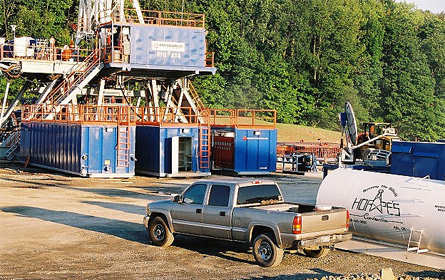Fracking Fight Sparks Intense Lobbying
In 2008, companies with a stake in natural gas drilling in New York spent a little less than $400,000 on lobbying. In 2009, that number tripled, with groups like the Independent Oil and Gas Association and Chesapeake Energy spending over $1,200,000. Lobbying dollars from the same sources only increased in 2010, hitting nearly $1,600,000.
What sparked that rise? Although most groups and companies spending that kind of money on lobbying have a myriad of issues before the state legislature, this spending spiked as the debate about the safety of hydraulic fracturing grew increasingly heated.
Hydraulic fracturing is the process by which natural gas is released from shale formations by injecting millions of gallons of water and chemicals into the earth. The natural gas industry says the process, along with the chemicals used, is safe, but there is concern that waste water from the process could contaminate local drinking supplies. The Environmental Protection Agency has discovered numerous pollutants in well water near fracking sites.
Common Cause, the good government group that conducted a recent study about the amount of lobbying dollars spent in the fight for and against what's known as hydrofracking, says that their study shows that those with more money are more likely to get heard.
"This is about big money and the influence it has on the debate. Those with the most money get heard," said Donna Bitetti of Common Cause. She says she is concerned about a recent deluge of television and radio advertising supporting hydrofracking, something groups like hers that oppose it or want to give environmental agencies more time to study the process simply cannot afford.
Looking for the Go-Ahead
Why have pro-fracking groups increased their spending? According to state Sen. Liz Krueger, an opponent of hydraulic fracturing who has introduced legislation that would steeply increase regulation of the process, the natural gas groups want the state legislature to quickly approve permits to allow fracking before scientific studies determine whether the process is safe or not.
Last year the legislature passed a moratorium on hydrofracking, a measure that was eventually vetoed by Gov. David Paterson. But Paterson then issued his own moratorium as an executive order to give the state Department of Environmental Conservation more time to study the process and the impact it may have on the environment. Meanwhile, the U.S. Environmental Protection Agency is doing its own study of the process. New York's moratorium expires on July 3. The state environment department is expected to unveil its study and new rules for hydraulic fracturing around then, and the public will have time to review and comment on the study before it becomes official.
It would be up to the DEC to allow permitting of hydrofracking in New York. The EPA conducted a study of hydrofracking in 2004 that found the process to be safe. Congress then passed legislation allowing states to regulate fracking individually. If the new EPA study finds fracking unsafe things could change.
But not all hydraulic fracturing that could affect New York's water supply is under exclusive control of New Yorkers.
In December 2010 the Delaware River Basin Commission, an interstate federal body led by the U.S. Army Corps of Engineers and including the U.S. Fish and Wildlife Service, the National Parks Service and the U.S. Environmental Protection Agency, proposed regulations to oversee hydrofracking. It estimates that 15,000 to 18,000 wells could be dug in the Delaware River Basin, most of them for the purpose of hydrofracking. Its unclear how many of those wells could be in New York but the fear is that 50 percent of New York City's drinking water comes from the basin, and a well in another state could affect the city's water supply.
New York Attorney General Eric Schneiderman, who has steadfastly opposed hydrofracking, issued an ultimatum earlier this week. Either the federal government does a full review of the environmental impact of the commission's guidelines within 30 days or Schneiderman will sue.
"Both the law and common sense dictate that the federal government must fully assess the impact of its actions before opening the door to gas fracking in New York," said Schneiderman in a statement.
The Independent Oil and Natural Gas Association responded with this statement: "It appears to us that the commission is indeed working to do what it always has: to prevent water pollution in the Delaware River Basin. There is no reason to believe that the DRBC might somehow do other than what it always has done -- protect water quality and water supply and conserve the resources of the basin for the public’s recreation and enjoyment. ... The attorney general's statements today appear to run counter to New York's duty as a member of the DRBC."
Billion Dollar Battle
The stakes are enormous. Some fracking advocates estimate that New York could see $3.8 billion in revenues from hydrofracking in the Marcellus Shale and, using Pennsylvania as an example, $400 million in tax revenues. Meanwhile they say local landowners and localities would benefit from an infusion of cash from n the purchase or leasing of land and from the new industry the wells would bring in.
Fracking supporters say this money would be a boon to upstate's ailing economy and could also help shift some energy use from coal and foreign oil to domestic natural gas which produces less of the gases that cause global warming.
Opponents, though, point to what they see as a myriad of risks. They express particular concern that fracking could endanger New York City's water supply, requiring the construction of filtering systems that could cost billions and might not even be able to remove dangerous substances from the city's water.
Faced with such criticism, Kruger said, the industry seems to recognize it is "losing the high ground in the debate. They are spending money on lobbying and putting pressure on New York to try to approve this before the government says this is not a good idea. They are trying to get ahead of the science."
Krueger points to a recent New York Times series that focused on the dangers of fracking and spotlighted the damage it has done in Pennsylvania and Wisconsin. The series unearthed federal government studies, allegedly buried by the Bush administration, that showed that fracking leads to pollution of well water. On top of that a recent study by Cornell University found that unearthing natural gas creates pollution as damaging to the environment as what's produced extracting coal.
James Smith, spokesman for gas association, denies that there is any rush. "The DEC has said they are not going to wait for the EPA. On July 1 we expect to have a new impact statement, and it will be open for comment a period. We hope it's short and everyone likes it. And then we hope they will start issuing permits," he said.
Smith also disagrees with Krueger that there has been a shift in the debate against fracking. "I think the debate has been pretty steady. There have been protests and rallies on both sides, op eds on both both sides."
The Court of Public Opinion
Smith says the industry may face a problem of perception. "It seems that the public has associated the word hydrofracking with pollution, and I think it got a bad rap," Smith said. "We still don't have any cases of ground water pollution due to hydrofracking -- that is not saying their haven't been issues elsewhere -- we just expect the regulations to be so tough in New York that it would minimize those type of events."
Krueger, however, says she thinks the message about the possible dangers of fracking is getting out despite the lobbying dollars spent to promote its alleged safety.
"Hydrofracking is the number one environmental issue. Not many people in New York live in western New York where the wells would be, but they have seen the pictures of Pennsylvania and watched the film Gasland. The New York Times has done a six-part series. So if you go up to someone in my district and say 'So, hydrofracking, huh?' they are very likely to say, 'Oh that is the thing that destroyed Pennsylvania and could pollute our water supply.'"
Bitetti of Common Cause isn't as confident. She has seen the lobbying dollars spent by the natural gas industry. She knows how much her group has spent in comparison to try to convince the public about what she believes are the dangers of fracking. And she has seen how the legislature has dealt with the issue.
She notes that the natural gas industry has been pouring money into PR and lobbying since way before the New York Times ran its series. Ads supporting fracking are commonplace on upstate television stations, and public radio. Thousands of fracking supporters -- residents of the areas that would stand to economically benefit -- have come to Albany en masse to lobby the legislature to allow them to use their land to make money.
Bitetti says she is encouraged that there are legislators like Krueger, "who introduced legislation that would basically ban fracking, but as soon as the legislation was introduced it was killed."
Krueger says she thinks the "grassroots" movement against fracking has taken off. She admits there isn't as much cash behind the push but she points to the anti-fracking lawn signs that cover some upstate neighborhoods, huge anti-fracking rallies in Albany and around the state, and the fact that fracking has become a hot environmental issue.
Tracking the Money
Common Cause and Bitetti now want to determine how much the natural gas industry has donated directly to politicians. That study, however, is difficult, as state campaign financing laws are not as strict as New York City's; individual donors don't have to name their employers. Along with that, it is hard to say that donations from the natural gas industry are aimed at promoting fracking, since the companies have other issues in front of the legislature, too.
Still, it is possible to get a basic idea of the kind of money that is pouring into politicians’ campaign chests. Gov. Andrew Cuomo received around $75,000 in donations from Competitive Power Ventures and its various subsidiaries. The company backs the use of natural gas and wind power -- two energies Cuomo supported in his energy position paper. Competitive Power Ventures has proposed building a natural gas plant in Wawayanda. N.Y.
Cuomo has received a number of smaller donations from companies interested in natural gas. He has raised the ire of advocates opposed to fracking by associating with members of the business community who have lobbied for fracking. He ationappointed one, Ken Addams, to be the CEO of the Empire State Development Corp. There is no clear connection between the coporation and the permitting of fracking, but anti-fracking advocates have taken it as a sign of who has Cuomo's ear. Adams as head of the Buisness Council strongly advocated to allow fracking.
The opponents just aren't sure where the most important decision makers stand.
Bitetti said she was encouraged when the new DEC commissioner said the new environmental impact statement would be released in the Summer and would allow for public comment. But her enthusiasm was tempered when nearly at the same time, "Norse Energy Corp. issued a random press release touting that they had had a great meeting with him just before he made the announcement."
Despite Key Setbacks, Bloomberg Plan Has Made New York Greener
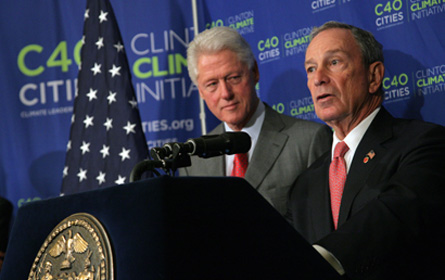
In an elaborately decorated parlor in Gracie Mansion, Mayor Michael Bloomberg and former President Bill Clinton last week each ticked off how he had personally become green.
Clinton bought a hybrid.
Bloomberg painted the roof of his Upper East Side townhouse white.
They both pushed for sustainable building.
"I'm devoting more time to the environment," said Bloomberg.
Bloomberg plans to encourage all New Yorkers to adopt those personal practices. And he's doing it through his environmental agenda: PlaNYC 2030. In December 2006, PlaNYC set out more than 120 initiatives, programs and goals to reduce carbon emissions by more than 30 percent over the next two decades and prepare the city for a population influx of 1 million people. It proposed regional parks, bike lanes, stormwater infrastructure, affordable housing and a green building code. According to Bloomberg's estimate, the city has already kicked off 97 percent of these initiatives.
"The vast bulk of these things we actually are doing, and they are making a difference," said Bloomberg.
Many advocates say the vast majority of the plan has been successful, but not all of it.
Since the plan's launch, the administration has been hit with several major defeats (most notably, congestion pricing), while some adopted proposals (ahem, bike lanes) currently face renewed opposition.
This week, Bloomberg is expected to release a retooled plan, announce new initiatives and incorporate the city's solid waste management strategy into his sustainability agenda. As the city plans for PlaNYC 2.0, officials and advocates question whether Bloomberg can accomplish all of the goals of the original plan in the face of a staggering economy and third termitis.
The Disappointments
First came congestion pricing -- the mayor's plan to charge drivers to enter Manhattan during the workweek.
The linchpin of the entire environmental agenda, the pricing plan failed to gain traction in Albany thanks to fierce opposition from legislators in the outer boroughs.
That defeat was followed by a series of court decisions striking down another PlaNYC proposal: the creation of an all hybrid-taxi fleet.
Then came the Great Recession and 10 rounds of budget cuts. Now, thanks to the economy, some programs have been abandoned altogether.
"We had our wins and our losses," said Rohit Aggarwala, the former head of the mayor's Office of Long-term Planning and Sustainability, who left the Bloomberg administration last year. "The biggest achievement that I'm most proud of is the green buildings package," Aggarwala said referring to legislation to reduce carbon emissions from buildings.
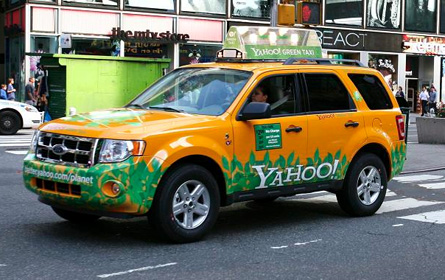
But, he added, "Congestion pricing was obviously a tragic loss. The hybrid taxis is kind of a mixed bag."
Some would call "mixed" generous.
The administration is set to select a new taxi model this month -- none of the cars under consideration are hybrids.
Beyond taxis, the city planned to open 43 sports fields across the city to their communities. That proposal has been abandoned, according to the latest PlaNYC status report.
By 2015, according to PlaNYC, the city would redevelop at least one underutilized major park in every borough. Construction was supposed to start on all eight by the end of 2010. Half -- Fort Washington Park, Highland Park, High Bridge and Soundview Park -- have yet to see a shovel in the ground.
The plan promised every New Yorker would live within walking distance of a park. Some advocates question whether that will ever happen.
"We thought we were going to get a waterfront park with an environmental education center and children's playground," said Elizabeth Yeampierre, the executive director of UPROSE, an environmental group in Sunset Park. "We thought we were going to get a greenway."
They have none of that, she said.
The city was supposed to complete 640 greenstreets, or thoroughfares with small islands with green space, by 2015. That number has been halved, according to a PlaNYC progress report. The administration originally committed to installing nighttime lights on 25 fields. That has been decreased to 19.
The plan called for encouraging home ownership and affordable housing. But the administration's preliminary budget has eliminated city funding for the Center for New York City Neighborhoods, which provides counseling for those at risk of foreclosure.
For its part, administration officials are quick to deflect blame and point fingers -- sometimes at Wall Street and the economy, other times at Washington or Albany.
"For those things that are within the city government's unilateral control, the transportation initiatives have been successful," said David Bragdon, the new head of the city's sustainability office. "Where the transportation objectives haven't been met, it's largely a function of state and or federal inaction."
Bragdon, who took over the mayor's sustainability office last year, said the administration is committed to seeing the plan through. Park construction is not eliminated, only delayed. As part of the city's budget cutting measures, the administration is stretching out projects over several more years.
In light of billion-dollar deficits, some advocates sympathized with Bloomberg, who has to weigh spending city funds on the creation of open space with keeping cops on the street.
"They've accomplished a lot already, and while it's frustrating that the progress has had to slow, it's still underway," said Alyson Beha, director of research, planning and programs at New Yorkers for Parks. "They are doing a fantastic job given the financial climate."
The Successes
Despite the setbacks, Bloomberg administration officials easily list the plan's accomplishments.
Just last week, the mayor lauded the 2-year old pedestrian plaza in Times Square for bringing down nitrogen dioxide and nitrogen oxide levels in the area (PlaNYC called for 10 to 15 public plazas across the city).
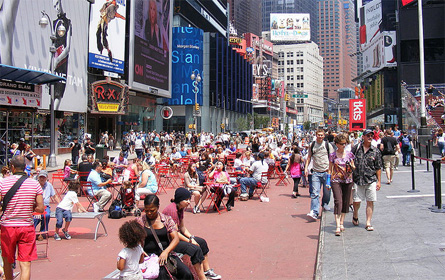
While major park construction has been delayed, the administration has been successful at opening school playgrounds to the public. As of April, 177 have been opened and 34 are currently under construction, according to a Bloomberg spokesperson.
Last month, Bloomberg and Council Speaker Christine Quinn announced the launch of East River ferry service between Brooklyn, Manhattan and Queens -- after much delay -- and committed $3.3. billion to the city's waterfronts.
Back on land, the administration has successfully launched the nation's first ever Office of Environmental Remediation -- the only city run brownfield cleanup program. The office aims to attract developers by providing start-up capital to clean up contaminated land, which does not qualify for state or federal programs. So far, said Daniel Walsh, the head of the office, eight developers have signed on and the city has approved $800,000 in grants.
"For us, it's a very good story," Walsh told the Gotham Gazette. "The economy has not stopped us from building programs and getting them in place."
Despite earlier criticism, most advocates champion new laws approved in 2009 to require buildings get energy audits. In an original version, the proposal would have forced building owners to complete the audit's recommendations. In a compromise with the real estate industry, that provision was scratched.
Nonetheless, advocates say the legislation would still be extremely effective at reducing pollution from buildings -- which are responsible for 80 percent of all the city's carbon emissions.
"From our members' perspective, brownfields, the green infrastructure, stormwater management plan, the greater greener buildings plans ... every one of those have had a disproportionately positive effect for environmental justice communities," said Eddie Bautista, a former member of the Bloomberg administration who now heads the Environmental Justice Alliance. "Had PlaNYC not prioritized these type of programs cumulatively, we would be talking about dirtier air, more un-remediated soil, more CO2 discharges."
But Bautista added: "The jury is out on moving forward in a budget challenged, in a deficit era."
Moving to 2.0
The next version of PlaNYC, which will be unveiled Thursday, is already getting mixed reviews.
"While on its face it looks like this great effort to address climate, it doesn't really address the environmental health needs of communities that really deserve it," said Yeampierre of UPROSE, who says projects in Manhattan are higher priorities than those in outer borough, poorer neighborhoods. "The more we learn about what's being proposed, the more we're concerned."
Some of the criticism from advocates like Yeampierre stems from the administration's renewed exploration of waste-to-energy -- otherwise known as the process of burning trash to create electricity. Solid waste management will be included in the plan for the first time, and some advocates fear communities already inundated with the city's garbage burden will face the prospect of new facilities.
Other environmentalists, like those at the New York League of Conservation Voters, are encouraging the administration to consider waste-to-energy facilities. Too much of the city's trash is taken to out of state landfills, said Marcia Bystryn, the group's executive director, at an extremely high financial and environmental cost.
Stakeholders do not anticipate a sea change this week considering the city's budget crunch. Advocates say it's a good sign the administration is willing to revisit the plan and consider new technologies that have emerged over the last five years. But they are far from claiming victory.
"The hard part of conveying this story is you can acknowledge the progress that has been made and still worry about the serious challenges yet to be addressed," said Eric Goldstein of the Natural Resources Defense Council. "Celebrating now would be premature."
Council Approves Bills to Regulate Snow Removal
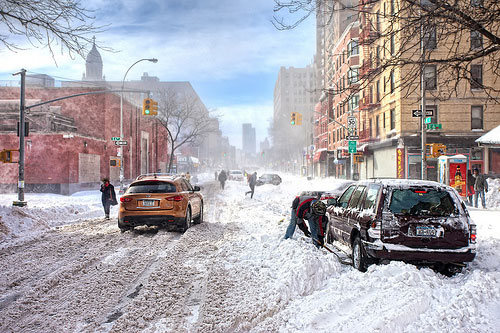
In response to the storm of criticism on the Bloomberg administration's response to last year's Boxing Day blizzard, the City Council approved a package of legislation Wednesday that outlines how the city should act in future snow emergencies.
The legislation caps off a round of public hearings hosted by the council, one in every borough, where New Yorkers shoveled out complaints over how slow the city was to plow streets and provide emergency services after the snowfall.
Council Speaker Christine Quinn said the package, which was approved almost entirely unanimously, would ensure the city was prepared to deal with another weather disaster.
"New Yorkers deserve and should expect a prepared city government," Quinn said. "We can't assume these things are going to happen."
When the legislation was first introduced, the Bloomberg administration criticized the proposals, arguing it needed its emergency regulations to be flexible. On Wednesday, however, a Bloomberg spokesperson said the mayor would support the measures.
The administration said it had worked with the council on the package, and attributed its reversal to revisions made to the proposal. For example, the council abandoned a requirement to force the city to suspend parking meters during snow emergencies.
Blizzard Backlash
The December blizzard dumped 20 inches of snow on the five boroughs and left streets unplowed, particularly in the outer boroughs, for more than three days. The city's 911 call system was overwhelmed and ambulances were blocked from responding to emergencies.
Quinn called the city's response "unacceptable."
Since the snowfall, the mayor's approval rating has plummeted to an eight year low. Most New Yorkers, according to a recent Marist College poll, believe the city is heading in the wrong direction. The city's slow snow response is credited with much of the Bloomberg bad sentiment.
Council officials said its legislative package would prevent similar incidents.
Under the package, the city's Office of Emergency Management would have to release an annual report evaluating the city's snow response. The office will also have to create formal protocols for weather emergencies that would outline when it should perform what duties and what would prompt a request for state aid.
Another bill will require the Department of Sanitation to create borough-based snow removal plans. As part of that proposal, the city will have to identify which streets get plowed when.
"People living on these streets will have a say," said Councilmember Jimmy Vacca, the chair of the Transportation Committee. "We're shedding light where there was none."
The city will be required to create a registry of snow removal volunteers and post what services are suspended online. The package also mandates the establishment of high-volume protocol for the city's 311 system, which would include the creation of a system to track complaints. Councilmember Gale Brewer abstained on both of these bills, arguing the policies didn't require legislation.
Every other bill was approved unanimously.
The council also called on the state to simplify the process for the city to use volunteer and private ambulances during emergencies.
In addition to the legislation, the Bloomberg administration and the council announced an agreement to force the company's snow removal contractor at bus shelters, Cemusa, to report to the Department of Transportation on its progress during storms. Originally, the council had proposed rescinding Cemusa's contract and requiring the Department of Transportation to remove the snow.
At least one councilmember argued the council was being too light on the administration.
"The mayor and the commissioner got away," said Councilmember Charles Barron.
Soaking up the Sun
In addition to the blizzard bills, the council also approved legislation that would exempt solar panels from height restrictions. It also approved legislation that would allow builders to use roofing materials that absorb less heat in the summer and reflect less in the winter.
The legislation, said council officials, would help reverse the city's heat island effect.
